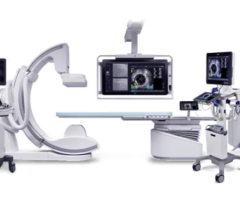The presentation of the ESC late-breaker TIDES-ACS results show us that the Optimax stent is noninferior in patients with acute coronary syndrome compared to Synergy.
November 24, 2017 – During a late-breaking session at the European Society of Cardiology (ESC) 2017 meeting, presented study results comparing titan nitride oxide (TiNO) coated stents (Optimax from Hexacath) versus the Synergy bioresorbable polymer coated everolimus-eluting stent (EES) from Boston Scientific, in patients with acute coronary syndrome (ACS) patients. The TIDES-ACS results show us that the Optimax stent is noninferior in patients with acute coronary syndrome compared to Synergy.
Dr. Pim Tonino, interventional cardiologist, Heart center Catharina Hospital, Eindhoven, the Netherlands, presented the study. Conducted in 12 international sites, this study randomized 1,491 ACS patients (2:1) to receive either TiNO-coated stents (989) or EES (502).
The primary endpoint was the rate of major adverse cardiac events (MACE), a composite of cardiac death, non-fatal myocardial infarction (MI) and ischemia-driven target lesion revascularization (TLR) at 12 months.
The primary end point occurred in 6.3 percent of patients receiving TiNO-coated stents, versus 7 percent of those receiving EES (HR 1.12 [95% CI 0.73 – 1.72] p for non-inferiority <0.001, p for superiority=0.66).
Both cardiac death (0.5 vs. 1.6 percent, respectively; p=0.04) and non-fatal MI (1.8 vs. 4.6 percent, respectively; p=0.004) were observed less frequently with TiNO-coated stents. Ischemia-driven TLR was undertaken more frequently in the TiNO-coated stent arm (5.4 vs. 3.4 percent, respectively; p=0.09).
“When you look at the individual components of the primary endpoint in this study, the Optimax stent comes with a lower rate of cardiac death and myocardial infarction compared to Synergy, which is outbalanced by a higher rate of ischemia-driven target lesion revascularization for Optimax. In other words, with the Optimax stent hard clinical endpoints like myocardial infarction and cardiac death are less frequent in ACS patients than with Synergy, at the cost of a, probably less important, higher rate of repeat intervention,” Tonino said.
In conclusion, for patients presenting with ACS, cobalt-chromium-based TiNO-coated stents were noninferior to platinum-chromium-based bioabsorbable polymer EES for the primary composite of safety and efficacy outcome at 12-month follow-up.
“The TIDES-ACS trial is the first adequately powered head-to-head randomized comparison of contemporary bioactive stent technology with cutting-edge DES technology, in the setting of ACS. It provided sound evidence of non-inferiority of the former, compared with the latter, for the composite of hard safety and efficacy endpoints,” said the principal investigator of this study, Dr. Pasi Karjalainen, from the Heart Center, Satakunta Central Hospital, Pori, Finland. “Based on this solid premise, we can advocate the use of TiNO-coated Bio Active Stent (BAS) as a worthwhile alternative to DES in ACS. It is our aspiration that stents based on this bioactive technology will be embraced by the upcoming Practice Guideline committees, as a viable and valid option for PCI in ACS patients. » he continued.
Hexacath is an independent French company founded in 1994 which develops, manufactures and distributes innovative vascular therapy products such as BAS, bare metal stents (BMS) and various types of PTCA and PTA catheters for coronary and peripheral indications.
Links to all the late-breaking ESC 2017 trial presentations.
For more information: www.hexacath.com


 December 20, 2023
December 20, 2023 








